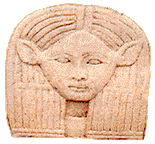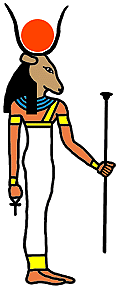

Hathor is a goddess who shifts and changes the more she is researched. I put off writing a report about her, daunted by the prospect of footnoting all the differing and conflicting information while coming up with my own conclusions.
In studying Hathor I read all the material submitted from various sources, checked out all the web references, and looked at all the pictures, and tried to immerse myself in the enigma of Hathor. I was privileged to attend two performances of an experiential guided journey with Hathor in rhythm, down the Nile. The second time was following a performance of a Mystery Play of the Ra-Sekhmet-Hathor myth, where Ra orders his daughter Sekhmet out into the world to destroy humanity. She goes out one day, does a great job, and begins to enjoy the taste of blood and destruction. She goes to sleep on the ground finally, and Ra feels sorry for humanity, and regrets setting Sekhmet on the world. He brews a beer from grain, and dyes it to look like blood. Sekhmet wakes, drinks the beer with gleeful abandon, thinking it blood, and falls asleep once again. When she wakes, she is Hathor, the gentle cow/sky goddess. This myth is exemplary of the misunderstandings and contradictions we find in the mythology of Hathor. Hathor is an older goddess than Sekhmet, but here we have her born of Sekhmet, born of the eye of Ra.
One problem of trying to pin down Egyptian deities, or neters, is found in the word neter. This word is often translated god and goddess, but is more properly translated as Divine Principle. In addition, the neters have a tendency to shift and change according to political boundaries and power plays. But this could be accepted within the Egyptian cosmology, although later Egyptologists would wonder how that could be.
We can trace the sky/cow goddess figure back before the beginnings of history. She is the loving virgin mother from whom all life springs. Even much later in Egyptian, and up to and including Roman times, where the tradition was to show deities only in profile, Hathor is still shown full-face, an archaic memory of her pre-historic countenance.
An interesting frame of reference I just read has the trio of Hathor-Bast-Sekhmet as the Maiden-Mother-Crone aspects. This is not generally accepted, but provides an interesting way of looking at the closely related trio. They can all be seen as various aspects of woman, the fiery angry Sekhmet, the loving, faithful Hathor, and the playful Bast.
Hathor is loveliness. Her cow face is the promise of a full belly, and love. The Greeks considered her a manifestation of Aphrodite, Goddess of Love. She cares for pregnant women, and watches over their childbirth. Seven Hathors appear after the birth of each child to announce its fate, and Hathor is required to infuse the child with life with her ankh, even after her creation functions were taken away by
She is the goddess of music, the sistrum, or shesheset is her instrument. Said to resemble the sound of papyrus, also sacred to Hathor, rustling. She is the patron of artists of all kinds, and festivities, and joyfulness, and dance. She was everything beautiful in all forms of woman.
She contains the Heavens in her body. She does not depend on a male god for her power, she merely is. Often portrayed as the wife of Horus, she is not dependent on him for power, she can still be the mother of all gods, just as Horus is often the Father or the Son.
Her color is gold, and she is powerful in her healing abilities. The Golden One is one of her many names. It is probable that the Golden Calf worshiped on Mt. Sinai was a representation of her son, Ihy. The casting out of the Golden Calf was also a casting out of the Hathor worshipers.
Hathor offers comfort to the newly dead as they enter the neterworld.
Hathor has for me become a part of Sekhmet, while also an older primeval Goddess, the sky-cow Goddess from the primitive days of man, the cow the first domesticated animal, giving life and food for the family. Sekhmet is the fire, cleansing and readying, and Hathor is the love and enjoyment. It is an issue of letting the Divine Feminine have all of its powers and attributes, and there is room for both Sekhmet and Hathor.
References and Links:
My Goddess-Study Email Group for which this research was done and with all the help of the wonderful women on this list.
Walk Like An Egyptian:
http://members.aol.com/tokapu/Walkle01.htm
Hathor Home Page
http://www.hathor.com/
Hathor, The Divine Flasher
http://www.hathor.com/flasher.htm
Sat Hathor Junit in front of a pyramid in old egypt
http://www.pege.org/fmiklis/pyramid.htm
Dendera
http://www.memst.edu/egypt/dendera.htm
Egypt Travel - Answan: The Temple of Hathor at Philae
http://touregypt.net/hathorphilae.htm
Egypt Information Page ~ By Nazik, Ben, Christina and Ryan http://geocities.datacellar.net/EnchantedForest/Dell/9137/
Permanent Collection - Ancient Egyptian Art
http://www.cc.emory.edu/CARLOS/egypt.gal.html
Ancient Egyptian Festival Calendar
http://www.netins.net/showcase/ankh/calendar.html
Per-Bast: The Domain of Bast
http://www.per-bast.org
Akhentef's World - The Gods and Goddesses of Ancient Egypt http://geocities.datacellar.net/Athens/Acropolis/3713/
Frequently Asked Questions and Information about Egyptian Mythology
http://www.contrib.andrew.cmu.edu/~eclectic/o/misc/egy.txt